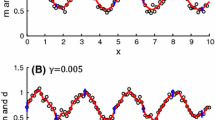Abstract
Principal component analysis models are widely used to model shapes in medical image analysis, computer vision, and other fields. The “Laplacian” spline approaches including thin-plate splines are also used for this purpose. These alternative approaches have complementary advantages and weaknesses: a low-rank principal component analysis model has some “knowledge” of the data being modeled, but cannot exactly fit arbitrary data, whereas spline models can fit arbitrary data but have only a generic smoothness assumption about the character of the data. In this contribution we show that the data fitting problem for these two approaches can be put into a common form, by making use of a relation between the data covariance and the Laplacian. This suggests the possibility of a unified approach that combines the advantages of each.
Access this chapter
Tax calculation will be finalised at checkout
Purchases are for personal use only
Similar content being viewed by others
References
Anjyo, K., Todo, H., J.: A practical approach to direct manipulation blendshapes. J. Graph. Tools 16(3), 160–176 (2012)
Bookstein, F.L.: Principal warps: thin-plate splines and the decomposition of deformations. IEEE Trans. Pattern Anal. Mach. Intell. 11, 567–585 (1989)
Botsch, M., Sorkine, O.: On linear variational surface deformation methods. IEEE Trans. Vis. Comp. Grap. 14(1), 213–230 (2008)
Chui, H., Rangarajan, A.: A new point matching algorithm for non-rigid registration. Comp. Vis. Image Underst. 89(2–3), 114–141 (2003)
Ding, C., Ye, J.: Two-dimensional singular value decomposition (2Dsvd) for 2D maps and images. In: Proceedings of SIAM international conference on data mining (SDM’05), pp. 32–43 (2005)
Donato, G., Belongie, S.: Approximate thin plate spline mappings. In: Proceedings of the 7th European conference on computer vision-Part III. ECCV’02, pp. 21–31. Springer, London, UK, UK (2002)
Dow, M.: Explicit inverses of Toeplitz and associated matrices. ANZIAM J. 44 E, E185–E215 (2003)
Fieguth, P.: Statistical Image Processing and Multidimensional Modeling. Information science and statistics. Springer, New York (2011)
Lewis, J., Hwang, H.J., Neumann, U., Enciso, R.: Smart point landmark distribution for thin-plate splines. In: Proceedings of SPIE medical imaging, pp. 1236–1243. San Diego (2004)
Pighin, F., Lewis, J.: Digital face cloning. SIGGRAPH Course. http://portal.acm.org (2005)
Pighin, F., Lewis, J.: Performance-driven facial animation. SIGGRAPH Course. http://portal.acm.org (2006)
Rao, K., Yip, P.: Discrete Cosine Transform: Algorithms, Advantages, Applications. Academic Press (1990)
Rasmussen, C., Williams, C.: Gaussian Processes for Machine Learning. Mit Press, Adaptive Computation And Machine Learning (2006)
Schneider, D., Eisert, P.: Fast nonrigid mesh registration with a data-driven deformation prior. In: IEEE 12th international conference on computer vision workshops (ICCV Workshops), pp. 304–311 (2009)
Seol, Y., Lewis, J., Seo, J., Choi, B., Anjyo, K., Noh, J.: Spacetime expression cloning for blendshapes. ACM Trans. Graph. 31(2), 14:1–14:12 (2012)
Strang, G.: The discrete cosine transform. SIAM Rev. 41(1), 135–147 (1999)
Tipping, M.E., Bishop, C.M.: Probabilistic principal component analysis. J. Royal Stat. Soc. Ser. B 61, 611–622 (1999)
Turk, G., O’Brien, J.F.: Shape transformation using variational implicit functions. In: Proceedings of the 26th annual conference on computer graphics and interactive techniques. SIGGRAPH’99, pp. 335–342. ACM Press/Addison-Wesley Publishing Co., New York, USA (1999)
Author information
Authors and Affiliations
Corresponding author
Editor information
Editors and Affiliations
Rights and permissions
Copyright information
© 2014 Springer Japan
About this paper
Cite this paper
Lewis, J.P., Rhee, T., Zhang, M. (2014). Principal Component Analysis and Laplacian Splines: Steps Toward a Unified Model. In: Wakayama, M., et al. The Impact of Applications on Mathematics. Mathematics for Industry, vol 1. Springer, Tokyo. https://doi.org/10.1007/978-4-431-54907-9_24
Download citation
DOI: https://doi.org/10.1007/978-4-431-54907-9_24
Published:
Publisher Name: Springer, Tokyo
Print ISBN: 978-4-431-54906-2
Online ISBN: 978-4-431-54907-9
eBook Packages: EngineeringEngineering (R0)




